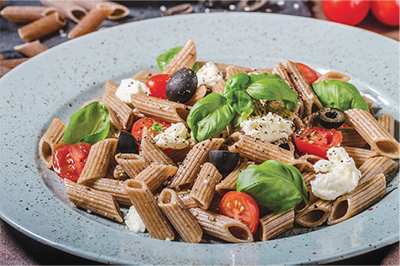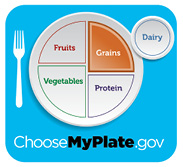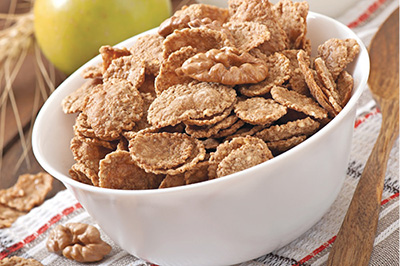MyPlate—The Grain Group: Make at Least Half Your Grains Whole Grains
Guide E-142
Revised by Raquel Garzon
College of Agricultural, Consumer and Environmental Sciences, New Mexico State University
Author: Extension Nutrition and Wellness Specialist, Department of Extension Family and Consumer Sciences, New Mexico State University. (Print Friendly PDF)
Introduction
The grain group includes foods such as bread, tortillas, rice, pasta, and breakfast cereals made from wheat, rice, oats, cornmeal, barley, or other grains. Foods from this group provide B vitamins (thiamine, riboflavin, niacin, and folate), minerals (iron), and fiber.
Grains are divided into two subgroups: whole grains and refined grains. Whole grains contain the entire grain kernel—bran, germ, and endosperm. In refined grains, the germ and bran have been removed, which also removes the fiber, iron, and B vitamins. Refined grains replace the B vitamins and minerals in a process called “enriching.” It is usually impossible to recover fiber. For these reasons, you should eat whole grains instead of refined grains.
Consuming whole grains as part of a healthy diet may help lower the risk of heart disease and type 2 diabetes as well as contribute to enhanced weight management.

© Peteer | Dreamstime.com
Nutrients in the Grain Group
The following nutrients are found in most grains. A typical American diet is at risk for being low in nutrients marked with an asterisk (*).
B vitamins release energy within the body, play an important role in metabolism, and help the nervous system work properly. Many refined grains are enriched with B vitamins.
*Fiber helps reduce blood cholesterol levels, may reduce the risk of heart disease, and promotes proper bowel function, including reducing constipation. Fiber-containing foods such as grains help provide a feeling of fullness with fewer calories.
*Folate helps produce red blood cells and reduces a woman’s risk of having a child with a brain or spinal cord defect.
*Iron is a mineral that carries oxygen in the blood to the body’s cells and helps protect against infections. Iron deficiency often leads to anemia, which causes you to feel tired and weak. Many women develop iron-deficiency anemia during their childbearing years and may need more meat and beans in their diet. To help reduce anemia, many foods are enriched or fortified with iron; breakfast cereals and flour are two examples.
Magnesium builds strong bones and helps muscles release energy.
Selenium is part of an antioxidant system and helps keep the immune system healthy.
How Many Grains are Needed?
MyPlate recommends eating between 3 and 8 ounces of grains every day, depending on your age, gender, and level of physical activity (Table 1). At least half of the servings should be from whole grains. For more information, visit www.choosemyplate.gov
MyPlate uses the term “ounce equivalent” when suggesting amounts of grain foods to consume.
What does a one-ounce equivalent from the grain group mean?
-
1 regular slice of bread
-
1 cup of ready-to-eat cereal
-
1/2 cup of cooked pasta, rice, or cereal
-
3 cups popcorn
-
1 3-inch bagel
-
1 small piece of cornbread (2 1/2 × 1 inch)
-
1 small tortilla (6-inch)
|
Table 1. Daily Recommendations for the Grain Group |
||
|
Age |
Ounces(s) |
|
|
Children |
2–3 years |
3 |
|
Girls |
9–13 years |
5 |
|
Boys |
9–13 years |
6 |
|
Women |
19–30 years |
6 |
|
Men |
19–30 years |
8 |
|
These amounts are appropriate for people who get less than 30 minutes per day of moderate exercise; those who are more physically active may be able to eat more than what is recommended in the table. |
||
Check the Label!
Being brown in color does not mean a product contains whole grain! Foods can be colored brown by adding molasses or caramel coloring. Products labeled with phrases such as “multi-grain,” “100% wheat,” or “all-bran” frequently are not made with whole grain. Read the label carefully and follow these tips:
-
Ingredients are listed in order from most to least in terms of amount. One of the first ingredients should be whole grain or the name of a certain grain (whole wheat, brown rice, rye). The word “whole” is critical to be on the food label to ensure it is truly whole grain.
-
Look at the ingredient list for added sugars (corn syrup, high-fructose corn syrup, sucrose, and molasses) and oils (partially hydrogenated vegetable oils) that add extra calories.
-
Look at the nutrition label and choose products with 3 grams or more of dietary fiber. Foods are good sources of fiber if they contain 2 1/2 to 5 grams of fiber per serving; 5 or more grams per serving means “high-fiber” food.
Tips for Eating More Whole Grains
-
Add whole grains to casseroles, soups, stews, salads, and meatloaf.
-
Try brown rice, quinoa, whole-wheat pasta, bulgur, or barley as a side dish.
-
Use unsweetened whole-grain cereal as breading for baked foods, as croutons for salads, or as crackers with soup.
-
Substitute at least half of the amount of white flour with whole-wheat flour in recipes.
-
Try whole-grain bread or tortillas.
© OlenaDanileiko | Dreamstime.com
“Go, Slow, Whoa” Foods
An easy way to make smart and nutritious choices within the grain group is to use the “Go, Slow, Whoa” concept.
-
“Go” foods are the most nutrient-dense; they contain more of the nutrients you need with relatively fewer calories. Eat them almost any time, based on your calorie needs.
- Examples: whole-grain breads, whole-grain tortillas, whole-grain pasta, brown rice, hot or cold unsweetened whole-grain breakfast cereals.
-
“Slow” foods are higher in calories, fat, and/or sugar than “Go” foods. Eat them sometimes, at most several times a week.
- Examples: white refined flour, bread, rice, and pasta; French toast; cornbread; biscuits; granola; waffles and pancakes.
-
“Whoa” foods are high in calories, fat, and/or sugar and offer little nutritional value. Eat them only once in a while or on special occasions, and in small portions.
- Examples: croissants, muffins, doughnuts, sweet rolls, crackers made with trans fats, sweetened breakfast cereals.
To learn more about “Go, Slow, and Whoa” foods, visit https://www.nhlbi.nih.gov/health/educational/wecan/eat-right/choosing-foods.htm
References
National Heart, Lung, and Blood Institute. 2012. Choosing foods for your family: GO, SLOW, and WHOA foods [Online]. https://www.nhlbi.nih.gov/health/educational/wecan/eat-right/choosing-foods.htm
United States Department of Agriculture. n.d. ChooseMyPlate.gov: All About the Grains Group [Online]. https://www.choosemyplate.gov/grains
For further reading
E-139: MyPlate - The Vegetable Group: Vary Your Veggies
https://pubs.nmsu.edu/_e/E139/
E-140: MyPlate - The Dairy Group: Get Your Calcium-Rich Foods
https://pubs.nmsu.edu/_e/E140/
E-141: MyPlate - The Fruit Group: Focus on Fruits
https://pubs.nmsu.edu/_e/E141/
E-143: MyPlate - The Protein Group: Go Lean With Protein
https://pubs.nmsu.edu/_e/E143/
 |
Visit ChooseMyPlate.gov for complete information on the MyPlate plan, including recipes, healthful eating tips, and tools to track your diet and exercise. |

Raquel Garzon is the Extension Nutrition and Wellness Specialist at NMSU. She has a doctorate in health science and is a Registered Dietitian. She has experience working as a clinical and community dietitian for adults and children, as well as working in the area of high-performance training for corporations and professional athletes. Her goal in Extension is to improve the well-being of New Mexicans through programs, collaborations, and education.
To find more resources for your business, home, or family, visit the College of Agricultural, Consumer and Environmental Sciences on the World Wide Web at pubs.nmsu.edu
Contents of publications may be freely reproduced, with an appropriate citation, for educational purposes. All other rights reserved. For permission to use publications for other purposes, contact pubs@nmsu.edu or the authors listed on the publication. New Mexico State University is an equal opportunity/affirmative action employer and educator. NMSU and the U.S. Department of Agriculture cooperating.
Revised December 2018 Las Cruces, NM



